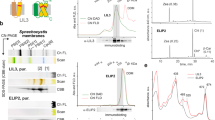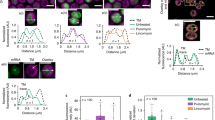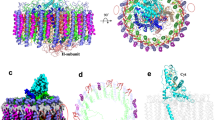Abstract
A molecule of chlorophyll is synthesized from eight molecules of δ-aminolevulinate (DALA), the universal precursor of porphyrins. The light-regulated conversion of glutamate to δ-aminolevulinate in the stroma of greening plastids involves the reduction of glutamate to glutamate-1-semialdehyde and its subsequent transamination1–5. The components performing this conversion have been isolated from barley1,2 and Chlamydomonas5 and separated into three fractions by serial affinity chromatography on Blue Sepharose and haem–1,5 or chlorophyllin–Sepharose2. The complete reaction can be performed in vitro in a reconstituted assay by combining all three fractions. An RNA is the essential component of the chlorophyllin–Sepharose-bound fraction2,3. By nucleotide sequence analysis, we have now identified this RNA as a chloroplast glutamate acceptor RNA. Glutamate attached by an aminoacyl bond to the 3′-terminal adenosine of this RNA is a substrate for the enzyme(s) which perform the subsequent reactions. This reaction represents a novel role for transfer RNA: participation in the metabolic conversion of its cognate amino acid into another metabolite of low relative molecular mass which subsequently is not used in peptide bond synthesis.
This is a preview of subscription content, access via your institution
Access options
Subscribe to this journal
Receive 51 print issues and online access
$199.00 per year
only $3.90 per issue
Buy this article
- Purchase on Springer Link
- Instant access to full article PDF
Prices may be subject to local taxes which are calculated during checkout
Similar content being viewed by others
References
Wang, W.-Y., Gough, S. P. & Kannangara, C. G. Carlsberg Res. Commun. 46, 243–257 (1981).
Kannangara, C. G., Gough, S. P., Oliver, R. P. & Rasmussen, S. K. Carlsberg Res. Commun. 49, 417–437 (1984).
Huang, D.-D., Wang, W.-Y., Gough, S. P. & Kannangara, C. G. Science 225, 1482–1484 (1984).
Kannangara, C. G., Gough, S. P. & von Wettstein, D. in Development in Plant Biology Vol. 2 (eds Akoyonoglou, G. & Akoyonoglou, J. H.) 147–160 (Elsevier, Amsterdam, 1978).
Wang, W.-Y., Huang, D.-D., Stachon, D., Gough, S. P. & Kannangara, C. G. Pl. Physiol. 74, 569–575 (1984).
Stanley, J. & Vassilenko, S. Nature 274, 87–89 (1978).
Donis-Keller, H., Maxam, A. M. & Gilbert, W. Nucleic Acids Res. 4, 2527–2537 (1977).
Krupp, G. & Gross, H. J. in The Modified Nucleosides in Transfer RNA II: A Laboratory Manual of Genetic Analysis, Identification and Sequence Determination (eds Agris, P. F. & Kopper, R. A.) 11–58 (Liss, New York, 1983).
Peattie, D. A. Proc. natn. Acad. Sci. U.S.A. 76, 1760–1764 (1979).
Domdey, H., Jank, P., Sänger, H. L. & Gross, H. J. Nucleic Acids Res. 5, 1221–1236 (1978).
Silberklang, M., Gillum, A. M. & RajBhandary, U. L. Meth. Enzym. 59, 58–109 (1979).
Ohashi, Z., Harada, F. & Nishimura, S. FEBS Lett. 20, 239–241 (1972).
Munninger, K. O. & Chang, S. H. Biochem. biophys. Res. Commun. 46, 1837–1842 (1972).
Nishimura, S. in tRNA: Structure, Properties and Recognition (eds Schimmel, P. R., Söll, D. & Abelson, J. N.) 551–552 (Cold Spring Harbor Laboratory, New York, 1979).
Saneyoshi, M. & Nishimura, S. Biochim. biophys. Acta 204, 389–399 (1979).
Gupta, R., Randerath, E. & Randerath, K. Nucleic Acids Res. 3, 2915–2921 (1976).
Raba, M. et al. Eur. J. Biochem. 97, 305–318 (1979).
Sprinzl, M., Moll, J., Meissner, F. & Hartmann, T. Nucleic Acids Res. 13, r1–r49 (1985).
Fox, G. E. et al. Science 209, 457–463 (1980).
Quigley, F. & Weil, J. H. Curr. Genet. 9, 495–503 (1985).
Ohme, M., Kamogashira, T., Shinozaki, K. & Sugiura, M. Nucleic Acids Res. 13, 1045–1056 (1985).
Kuntz, M., Weill, J. H. & Steinmetz, A. Nucleic Acids Res. 12, 5037–5047 (1984).
Rasmussen, O. F., Stummann, B. M. & Henningsen, K. W. Nucleic Acids Res. 12, 9143–9153 (1984).
Holschuh, K., Bottomley, W. & Whitfield, P. R. Pl. molec. Biol. 3, 313–317 (1984).
Hollingsworth, M. J. & Hallick, R. B. J. biol. Chem. 257, 12795–12799 (1982).
Silberklang, M., Gillum, A. M. & RajBhandary, U. L. Nucleic Acids Res. 4, 4091–4108 (1978).
Martin, R. P., Schneller, J. M., Stahl, A. J. C. & Dirheimer, G. Nucleic Acids Res. 4, 3497–3511 (1977).
Poulsen, C. Carlsberg Res. Commun. 48, 57–80 (1983).
Nesbitt, J. A. & Lennartz, W. J. J. biol. Chem. 243, 3088–3095 (1968).
Leibowitz, M. J. & Soffer, R. L. Biochem. biophys. Res. Commun. 36, 47–53 (1969).
Bumsted, R. M., Dahl, J. M., Söll, D. & Strominger, J. L. J. biol. Chem. 249, 4787–4796 (1974).
Ciechanover, A., Wolin, S., Steitz, J. A. & Lodish, H. F. Proc. natn. Acad. Sci. U.S.A. 82, 1341–1345 (1985).
Wilcox, M. & Nirenberg, M. Proc. natn. Acad. Sci. U.S.A. 61, 229–236 (1968).
Henner, D. J. & Hoch, J. A. Microbiol. Rev. 44, 57–82 (1980).
McKie, J., Lucas, C. & Smith, A. Phytochemistry 20, 1547–1549 (1981).
Weinstein, J. D. & Beale, S. I. Archs Biochem. Biophys. 239, 87–93 (1985).
Bischoff, R. E., Graeser, E. & McLaughlin, L. J. Chromat. 257, 305–315 (1983).
Beier, H., Barciszewska, M., Krupp, G., Mitnacht, R. & Gross, H. J. EMBO J. 3, 351–356 (1984).
Maniatis, T., Fritsch, E. F. & Sambrook, J. Molecular Cloning, a Laboratory Manual (Cold Spring Harbor Laboratories, New York, 1982).
Author information
Authors and Affiliations
Rights and permissions
About this article
Cite this article
Schön, A., Krupp, G., Gough, S. et al. The RNA required in the first step of chlorophyll biosynthesis is a chloroplast glutamate tRNA. Nature 322, 281–284 (1986). https://doi.org/10.1038/322281a0
Received:
Accepted:
Issue Date:
DOI: https://doi.org/10.1038/322281a0
This article is cited by
-
Effects and Regulatory Mechanism of Exogenous H2O2 on Amino Acid Metabolism in Post-harvest Broccoli: An Integrated Analysis of Transcriptomic and Metabolomic
Food and Bioprocess Technology (2024)
-
Metabolic engineering of Escherichia coli BW25113 for the production of 5-Aminolevulinic Acid based on CRISPR/Cas9 mediated gene knockout and metabolic pathway modification
Journal of Biological Engineering (2022)
-
CRISPR/Cas9 mediated T7 RNA polymerase gene knock-in in E. coli BW25113 makes T7 expression system work efficiently
Journal of Biological Engineering (2021)
-
Modular control of multiple pathways of Corynebacterium glutamicum for 5-aminolevulinic acid production
AMB Express (2021)
-
Downregulating of hemB via synthetic antisense RNAs for improving 5-aminolevulinic acid production in Escherichia coli
3 Biotech (2021)
Comments
By submitting a comment you agree to abide by our Terms and Community Guidelines. If you find something abusive or that does not comply with our terms or guidelines please flag it as inappropriate.



